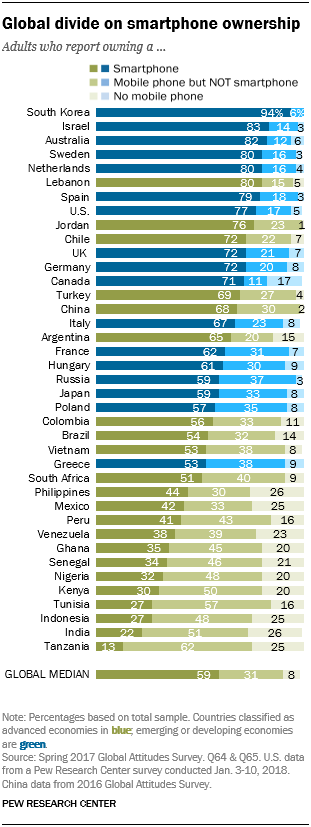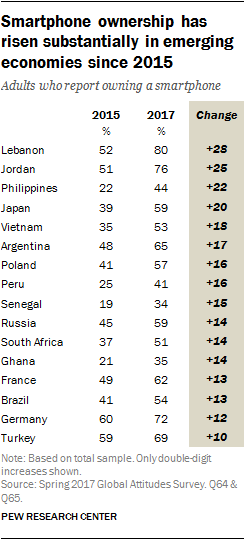 Mobile phones, like the internet, play an important role in modern society. And in poorer countries where fixed internet use is not as widespread, mobile phones can be extremely important tools – whether helping poor people gain access to financial services or providing much-needed assistance with health or agricultural needs.
Mobile phones, like the internet, play an important role in modern society. And in poorer countries where fixed internet use is not as widespread, mobile phones can be extremely important tools – whether helping poor people gain access to financial services or providing much-needed assistance with health or agricultural needs.
While mobile phone ownership is widespread across the countries surveyed, smartphone ownership is far less common. At least three-in-four or more adults report owning a mobile phone in every country surveyed. But while a global median of 59% report owning a smartphone, in just nine of the countries surveyed do about three-quarters or more say they own a smartphone.
In 12 of the 22 emerging and developing nations surveyed, fewer than 50% report owning a smartphone. And in India and Tanzania, fewer than one-quarter report owning smartphones, the lowest among the countries surveyed.
Among emerging and developing nations, Middle Eastern countries in particular have high rates of smartphone ownership, including 80% in Lebanon and 76% in Jordan.
Similar to internet use, smartphone ownership is lowest in sub-Saharan Africa, where a median of 33% report owning a smartphone.
Asia-Pacific (53%) and Latin America (54%) are closer to Europe (70%) in median smartphone ownership than they are to sub-Saharan Africa.
Smartphone ownership growing
 Smartphone ownership has been on the rise since 2015, with especially large increases occurring in Lebanon (+28 percentage points), Jordan (+25) and the Philippines (+22).
Smartphone ownership has been on the rise since 2015, with especially large increases occurring in Lebanon (+28 percentage points), Jordan (+25) and the Philippines (+22).
Similar to internet use, smartphone ownership varies by age and educational attainment in every country surveyed. The largest generational divide is in Greece, where 93% of those ages 18 to 36 own a smartphone, compared with 38% of those 37 or older.
The educational divide in smartphone ownership is much more prevalent among emerging and developing economies. The gap in smartphone ownership between those with more and less education is 40 percentage points or more in 12 of the countries surveyed. Just one of these 12 countries is an advanced economy: Greece (40-point gap).
There is also a significant divide by individual income levels when it comes to smartphone ownership. The biggest income gap is in Peru, where six-in-ten among those with higher incomes say they own a smartphone, compared with only 24% among those with lower incomes. But significant, double-digit divides by income on smartphone ownership exist in all the other countries surveyed, with the exception of Lebanon.
Gender is a less common divide in smartphone ownership, but still exists in 13 of the countries surveyed. Men are at least 10 percentage points more likely than women to own smartphones in India, Mexico, Ghana, Kenya, Chile and Hungary. Notably, Lebanese women are more likely than men to own a smartphone, while men are more likely than women to own a basic mobile phone.


